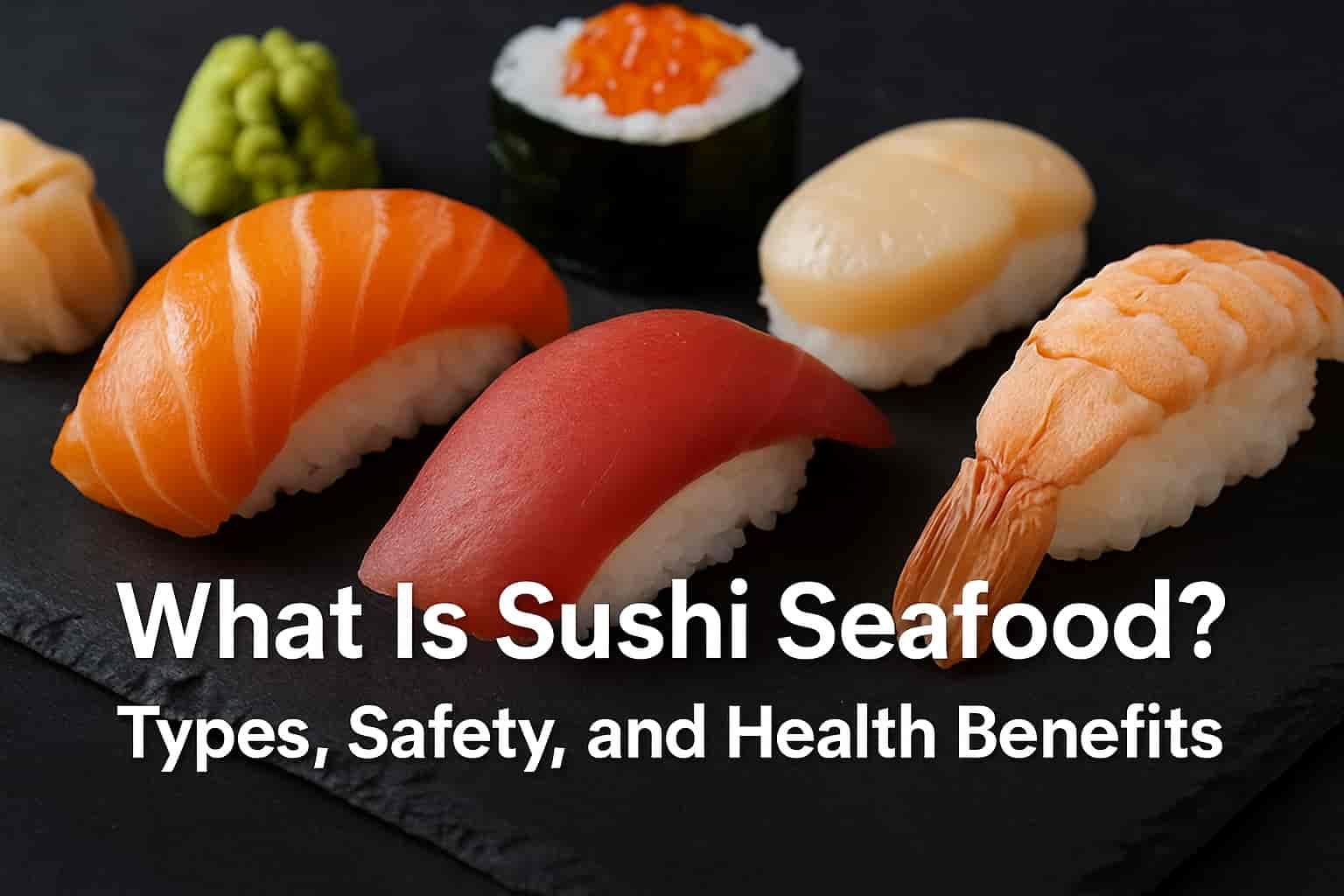Sushi seafood represents the pinnacle of culinary precision and food safety. Unlike regular seafood, sushi-grade seafood must meet rigorous quality and safety standards to be consumed raw without health risks. This category includes premium cuts of fish and shellfish specifically selected for their freshness, texture, and taste.
Consumers often assume that any fresh fish is suitable for sushi, but this is incorrect. Sushi seafood must be processed under strict temperature controls and often undergoes flash freezing to eliminate parasites, as required by FDA regulations. The global popularity of sushi, combined with health-conscious dining trends, has increased demand for high-quality sushi seafood.
This article answers critical questions about sushi seafood, including which types are most popular, how to verify safety, and where to purchase them reliably. Whether you are an aspiring home chef or a curious diner, understanding these facts ensures that every sushi experience is both delicious and safe.
Contents
- 1 What Types of Seafood Are Commonly Used in Sushi?
- 2 What Makes Seafood Sushi-Grade and Safe to Eat Raw?
- 3 How Can You Tell If Sushi Seafood Is Fresh and High-Quality?
- 4 Where Can You Buy Sushi-Grade Seafood Safely?
- 5 How Should You Store Sushi Seafood at Home to Maintain Freshness?
- 6 What Are the Health Benefits of Eating Sushi Seafood?
- 7 Are There Any Health Risks Associated with Eating Sushi Seafood?
- 8 How Is Sushi Seafood Prepared in Professional Kitchens?
- 9 How Do Sushi Chefs Select the Best Seafood for Their Dishes?
- 10 Can You Prepare Sushi Seafood Dishes at Home Like a Chef?
- 11 Final Recommendations for Enjoying Sushi Seafood Safely and Deliciously
What Types of Seafood Are Commonly Used in Sushi?
The most commonly used seafood in sushi includes tuna, salmon, yellowtail, shrimp, and scallops. These varieties meet flavor expectations, textural requirements, and food safety standards necessary for raw consumption.
What Is the Best Fish for Sushi?
The top 5 fish used for sushi are tuna, salmon, yellowtail, mackerel, and halibut.
- Tuna (Maguro) offers a meaty texture and rich flavor. Bluefin tuna, though expensive, is highly prized for its fat marbling.
- Salmon (Sake) is known for its vibrant color and buttery texture. Only farmed salmon is used due to lower parasite risk.
- Yellowtail (Hamachi) delivers a mildly sweet flavor and is often featured in nigiri.
- Mackerel (Saba) is preferred for its strong umami taste and is typically marinated to enhance flavor.
- Halibut (Hirame) provides a light, clean taste ideal for sashimi.
Can You Use Shellfish in Sushi?
Yes, 4 common shellfish used in sushi include shrimp, scallops, squid, and octopus.
- Shrimp (Ebi) is often boiled and served atop nigiri.
- Scallops (Hotate) offer a sweet, delicate flavor ideal for sashimi and nigiri.
- Squid (Ika) is valued for its firm texture and subtle sweetness.
- Octopus (Tako) is typically served cooked due to its chewy texture and stronger flavor.
Are There Vegetarian Alternatives to Traditional Sushi Seafood?
There are 3 popular vegetarian alternatives: tofu, avocado, and cucumber.
- Tofu serves as a protein-rich replacement in sushi rolls.
- Avocado adds creaminess and healthy fats to vegetarian sushi options.
- Cucumber provides freshness and crunch, often used in maki rolls like Kappa Maki.
What Makes Seafood Sushi-Grade and Safe to Eat Raw?
Seafood is classified as sushi-grade only if it meets specific safety standards, including parasite destruction and proper handling procedures.
What Are the Parasite Destruction Guidelines for Raw Seafood?
The FDA requires all fish intended for raw consumption to be frozen at -20°C (-4°F) for at least 7 days or -35°C (-31°F) for 15 hours. This process kills parasites such as Anisakis that are commonly found in wild fish.
How Does Flash Freezing Ensure Food Safety?
Flash freezing locks in freshness and eliminates parasites, making the seafood safe for raw consumption. This technique involves rapidly freezing the fish at ultra-low temperatures immediately after harvest. It prevents ice crystals from forming, preserving the fish’s cellular structure and texture.
High-end suppliers consistently use flash freezing combined with vacuum sealing to maintain safety and flavor during transportation and storage. Without this process, consuming raw fish poses serious health risks, including parasitic infections and foodborne illnesses.
How Can You Tell If Sushi Seafood Is Fresh and High-Quality?
Fresh, high-quality sushi seafood is identified by its vibrant color, clean aroma, firm texture, and moisture-rich appearance. These characteristics indicate that the seafood is suitable for raw consumption and free from spoilage.
What Are the Visual Signs of Fresh Sushi-Grade Fish?
Fresh sushi-grade fish displays bright, translucent flesh and vibrant natural colors.
- Tuna should have a deep red to pink hue, free from brown or gray discoloration.
- Salmon must exhibit bright orange to reddish-orange tones with visible fat marbling.
- Yellowtail should appear slightly pink with a glossy sheen.
Fish eyes, if present, should be clear and bulging, not cloudy or sunken. Gills must be bright red without any slimy residue.
How Should High-Quality Sushi Seafood Smell and Feel?
High-quality sushi seafood has a clean, ocean-fresh scent without any fishy or sour odors.
- The texture should be firm and resilient to gentle pressure.
- The surface should feel slightly moist but not slimy or sticky.
When pressed, the flesh should bounce back immediately. If it leaves an indentation, the seafood is no longer fresh and should not be consumed raw.
Where Can You Buy Sushi-Grade Seafood Safely?
Sushi-grade seafood should only be purchased from reputable fish markets, certified online suppliers, or specialty seafood stores that follow FDA food safety protocols.
Trusted retailers provide documentation of flash freezing processes and parasite destruction compliance. Always request information about sourcing and handling practices before purchasing.
Should You Buy Sushi Seafood Online? (Pros and Cons)
Buying sushi seafood online is safe if the supplier provides verified sourcing, proper packaging, and expedited shipping.
- Advantages:
- Access to rare and premium seafood like Otoro (fatty tuna) and Uni (sea urchin).
- Vacuum-sealed and flash-frozen shipments ensure freshness upon arrival.
- Convenience for consumers living far from coastal areas.
- Disadvantages:
- Higher shipping costs due to temperature-controlled packaging.
- Risk of delayed delivery affecting product quality.
Reliable online sources should always provide tracking information and guarantee overnight or two-day delivery using insulated containers with dry ice.
How Should You Store Sushi Seafood at Home to Maintain Freshness?
Sushi seafood must be stored at temperatures below 4°C (39°F) and consumed within 24 to 48 hours for optimal safety and quality.
For longer storage, the seafood should be vacuum-sealed and flash-frozen at -20°C (-4°F) or lower. This prevents bacterial growth and preserves texture and flavor.
- Refrigeration Guidelines:
- Place seafood on a bed of ice in a sealed container to maintain a consistent low temperature.
- Keep it on the lowest shelf of the refrigerator to avoid temperature fluctuations.
- Freezing Guidelines:
- Use vacuum-sealed bags to prevent freezer burn.
- Label packages with the date of freezing and consume within 3 months for best quality.
Never refreeze sushi seafood once thawed. To thaw safely, transfer the seafood from the freezer to the refrigerator for slow defrosting over 12 to 24 hours. This preserves texture and minimizes bacterial contamination.
What Are the Health Benefits of Eating Sushi Seafood?
Eating sushi seafood provides significant health benefits, including improved heart health, better weight management, and enhanced cognitive function. These advantages are primarily due to the high content of omega-3 fatty acids, lean protein, and essential vitamins.
Is Sushi Seafood Good for Weight Management?
Yes, sushi seafood supports weight management by providing high-quality protein with low saturated fat content.
- A typical serving of sashimi contains approximately 20–25 grams of protein and less than 5 grams of fat.
- Protein increases satiety, helping reduce overall calorie intake during meals.
- Sushi seafood, such as tuna and salmon, promotes lean muscle retention while supporting fat loss.
Including sushi seafood in a balanced diet helps maintain a healthy body composition without excessive calorie consumption.
How Does Sushi Seafood Support Heart Health?
Sushi seafood supports heart health by delivering high concentrations of omega-3 fatty acids, particularly EPA and DHA.
- Consuming 100 grams of salmon provides approximately 2 grams of omega-3, which effectively reduces triglyceride levels.
- Regular intake of omega-3-rich fish lowers the risk of cardiovascular diseases by improving arterial elasticity and reducing inflammation.
The American Heart Association recommends eating at least two servings of fatty fish per week to promote optimal heart function.
Are There Any Health Risks Associated with Eating Sushi Seafood?
While sushi seafood offers health benefits, consuming it without proper precautions can lead to serious health risks, including parasitic infections, mercury exposure, and bacterial contamination.
What Parasites and Bacteria Should You Be Concerned About?
The primary parasites of concern in raw seafood are Anisakis and Diphyllobothrium tapeworms.
- Anisakis larvae can cause anisakiasis, leading to abdominal pain and digestive issues.
- Proper freezing at -20°C (-4°F) or below for at least 7 days eliminates these parasites.
Bacterial risks include Vibrio, Listeria monocytogenes, and Salmonella, which can cause food poisoning if the seafood is improperly handled.
Can Eating Too Much Sushi Seafood Lead to Mercury Exposure?
Yes, excessive consumption of large predatory fish like tuna and swordfish can result in mercury accumulation.
- The FDA advises limiting consumption of high-mercury fish to no more than 170 grams per week.
- Pregnant women and young children should avoid high-mercury species altogether to prevent neurological risks.
How Can You Minimize Health Risks When Consuming Raw Seafood?
To minimize health risks, purchase only certified sushi-grade seafood, verify parasite destruction compliance, and consume within recommended time frames.
- Avoid consuming raw seafood from uncertified sources.
- Always store sushi seafood at proper refrigeration temperatures below 4°C (39°F).
- Limit intake of high-mercury species and diversify seafood choices to include lower-mercury options like salmon and shrimp.
How Is Sushi Seafood Prepared in Professional Kitchens?
In professional kitchens, sushi seafood preparation follows strict hygiene standards, precise cutting techniques, and careful handling to preserve freshness and ensure safety.
- Chefs use sterilized knives and cutting boards specifically designated for raw seafood to prevent cross-contamination.
- Fish is sliced against the grain to maintain texture and enhance the mouthfeel.
High-end establishments often operate under a HACCP (Hazard Analysis Critical Control Points) plan, which outlines critical safety controls for handling raw seafood.
Key Preparation Steps Include:
- Visual and olfactory inspection to ensure freshness.
- Filleting and portioning with specialized sushi knives.
- Immediate refrigeration or placement on ice after preparation.
By adhering to these protocols, sushi chefs ensure that the seafood served is both safe to eat and delivers the optimal sensory experience expected in high-quality sushi.
How Do Sushi Chefs Select the Best Seafood for Their Dishes?
Professional sushi chefs select seafood based on strict criteria, including freshness, fat content, color, and sustainability certifications.
- Freshness: Chefs examine the clarity of fish eyes, the bright red color of gills, and the firmness of the flesh. Any signs of discoloration or unpleasant odors immediately disqualify the seafood.
- Fat Content: High-quality cuts such as Otoro (fatty tuna belly) are highly prized for their rich marbling, which enhances flavor and texture.
- Color and Appearance: Fish with vibrant, natural colors and translucent flesh are preferred. For example, premium salmon must exhibit a bright orange hue with evenly distributed fat lines.
- Sustainability: Top chefs prioritize seafood sourced from sustainable fisheries with certifications like MSC (Marine Stewardship Council) to ensure environmental responsibility.
Exclusive seafood auctions, such as the Toyosu Market in Tokyo, remain critical venues where experienced chefs personally inspect and bid for the finest seasonal catches. These selections directly influence the quality and prestige of their dishes.
Can You Prepare Sushi Seafood Dishes at Home Like a Chef?
Yes, you can prepare sushi seafood dishes at home by following proper food safety protocols, using the right equipment, and practicing fundamental cutting techniques.
- Essential Equipment:
- A sharp sashimi knife (yanagiba) for precise slicing.
- A bamboo mat (makisu) for rolling maki sushi.
- Rice paddle and wooden bowl for preparing sushi rice (shari).
- Basic Sushi Recipes for Beginners:
- Nigiri Sushi: Shape seasoned sushi rice into small oblong mounds and top with thin slices of raw fish.
- Maki Rolls: Place a sheet of nori on the bamboo mat, spread a thin layer of sushi rice, add seafood and vegetables, and roll tightly.
- Sashimi: Slice chilled seafood into uniform pieces served without rice.
Important Food Safety Reminder: Always use certified sushi-grade seafood and maintain strict hygiene standards during preparation. Store seafood at temperatures below 4°C (39°F) and consume immediately after preparation to ensure freshness and safety.
Final Recommendations for Enjoying Sushi Seafood Safely and Deliciously
To fully enjoy sushi seafood, focus on sourcing the highest quality products, practicing safe handling techniques, and balancing your consumption for optimal health benefits.
- Choose Trusted Sources: Always purchase from suppliers that follow FDA regulations and provide clear documentation on freezing protocols.
- Diversify Seafood Choices: Balance your intake between low-mercury options like salmon, shrimp, and scallops to reduce health risks.
- Practice Proper Storage: Refrigerate seafood immediately and consume it within 24 to 48 hours for peak freshness.
- Moderate Raw Consumption: Limit the intake of raw seafood if you are pregnant, immunocompromised, or concerned about mercury exposure.
By applying these practices, you can enjoy the rich flavors and nutritional advantages of sushi seafood with confidence and safety. For those interested in preparing seafood at home, start by mastering basic recipes and gradually refine your skills.
If you’re also concerned about seafood hygiene before preparation, explore our detailed guide on How to Clean Seafood Properly to ensure every dish meets the highest safety standards.



